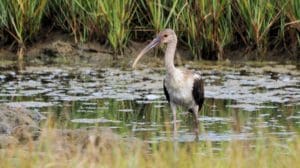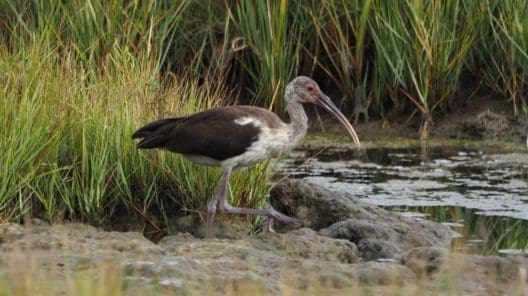White Ibis

By the end of the month of August 2022, CT had recorded 317 species on eBird. Ten new species were added during August (see the image below, which is an eBird SYL list sorted by date), and White Ibis was the 316th species added, reported to eBird on August 22 by Cody Limber. Our team voted and unanimously chose White Ibis as the #1 BOTM for August.
The individual that initially found the birds at Old Saybrook was John Michael Arnett. He was surveying the area for Diamond-backed Terrapin and came across the Ibis. He posted to iNaturalist where Alex Lin Moore saw the post and alerted the Connecticut birding community.
White Ibis immature with prey (mummichog?) Photos by Ed Haesche
Noted by Frank Gallo in a New Canaan Nature Center posting:
“On 11 August 2022, an unprecedented 29 young White Ibis were sighted in a marsh in Wells, Maine, hundreds of miles north of their closest breeding grounds, a small colony in southern New Jersey. In Connecticut, six were seen in Plum Bank Marsh, in Old Saybrook on 21 August 2022. What were they doing in Maine and Connecticut? This summer wandering, often far from their breeding sites, is known as post-breeding dispersal, were a variety of species, including herons, some raptors, and even bears, roam, perhaps in search of productive feeding sites, or to locate future breeding territories.”
Monica Nichols provided this interesting viewpoint on White Ibis in NJ:
“When I started going into Ocean City, NJ for birding in 2019, they hadn’t yet been seen. In 2020, the following year there was one or two. In 2021, they started breeding there with half a dozen pairs. In this year when I went, the rookery was full of them. More white ibis breeding than any other heron/egret. Crazy to say the least!”
The stats on White Ibis, for CT, from ARCC’s Phil Rusch:
There are 11 Accepted Records, 1 not accepted record, and 8 not reviewed records including this year’s Plum Bank Marsh birds. The first accepted record was 30 Aug 1980 in Stratford at Lordship by D Sibley.
eBIRD MAPS FOR THESE WHITE IBISES:
As you know, eBird maps use blue and red pins/icons to display the locations of birds reported. The red pins indicate reports in the most recent thirty days, and after that time, the red pins change color to become blue pins. The red pin(s) in the several eBird maps below show the White Ibises reported in CT this month (“recently”, i.e., during this 30 day period: August 1 through August 31, 2022)…
These eBird maps were taken from the internet as of August 31, 2022 at 3am.
Note the significant number of White Ibises in New England in the last 30 days (the red pins), during August. And zooming out further (below), note the very large number in August south of us (in coastal New Jersey, Delaware Bay, etc)…
REFERENCES:
White Ibis in the public news: https://nj1015.com/a-tropical-looking-bird-species-is-now-calling-nj-home/
Climate Adaptation Explorer: https://climateadaptationexplorer.org/species/birds/172
Wikipedia: White Ibis: https://en.wikipedia.org/wiki/American_white_ibis
AND a map which will need updating https://en.wikipedia.org/wiki/American_white_ibis#/media/File:Eudocimus_albus_map_2.svg
eBird article on White Ibis:: https://ebird.org/species/whiibi
Audubon Guide to North American Birds: https://www.audubon.org/field-guide/bird/white-ibis
Good article, including information on this species range expanding.
“The movements of a recently urbanized wading bird reveal changes in season timing and length related to resource use”. https://www.ncbi.nlm.nih.gov/pmc/articles/PMC7082014/
“Foraging in Urban Environments Increases Bactericidal Capacity in Plasma and Decreases Corticosterone Concentrations in White Ibises.” https://www.frontiersin.org/articles/10.3389/fevo.2020.575980/full
Birds Of The World link, regarding diet of this species: https://birdsoftheworld.org/bow/species/whiibi
Diet and Foraging: Major Food Items
Small aquatic and semiaquatic organisms, especially crustaceans and aquatic insects. Also fish, especially when these occur in high densities. Specialize on crustaceans, especially freshwater crayfish (Cambaridae) and estuarine crabs (Ocypodidae; Nesbitt et al. 1975, Kushlan and Kushlan 1975, Kushlan 1979d, Bildstein 1983). Total diet is nevertheless exceptionally broad because of ability to pick up whatever items they touch with their bill.
Diet includes aquatic and terrestrial arthropods, polychaetes, snails, frogs, lizards, young snakes, newts (Kushlan 1980), and small fish. Outside the nesting season ibises are primarily coastal, most using mangrove swamps, Spartina marshes, and coastal lagoons, where they often specialize on fiddler crabs (Uca). However, in winter many forage in freshwater areas, particularly in s. Florida. In non-breeding season in Florida, earthworms, cockroaches and other insects in lawns are common prey, especially during the wet season when flooded wetlands are typically too deep for foraging…
Crossley ID Guides online:
“White Ibis range spreading to New Jersey shore” Philadelphia Inquirer
https://www.inquirer.com/news/new-jersey/white-ibis-new-jersey-shore-climate-change-20220812.html

